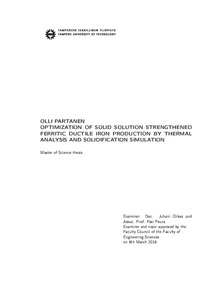Optimization of solid solution strengthened ferritic ductile iron production by thermal analysis and solidification simulation
Partanen, Olli Antero (2016)
Partanen, Olli Antero
2016
Materiaalitekniikan koulutusohjelma
Teknisten tieteiden tiedekunta - Faculty of Engineering Sciences
This publication is copyrighted. You may download, display and print it for Your own personal use. Commercial use is prohibited.
Hyväksymispäivämäärä
2016-05-04
Julkaisun pysyvä osoite on
https://urn.fi/URN:NBN:fi:tty-201604203822
https://urn.fi/URN:NBN:fi:tty-201604203822
Tiivistelmä
The newest EN 1563 standard about ductile iron castings was published in 2011. The standard contains three new solid solution strengthened ferritic ductile iron grades: 450–18, 500–14 and 600–10. There are some studies for laboratory scale SSF samples, but very few studies about actual full scale SSF ductile iron production. The objective of this thesis was to gain more insight about the specifics of SSF ductile iron production.
The theory portion of this thesis consists of a literature survey that focuses on cast iron metallurgy, ductile iron melt processes and cooling curve analysis of cast irons. The experimental part of this thesis consists of two production trials of 600–10 ductile iron and several linked cooling curve analyses and solidification simulations.
The production trials were not completely successful. Different separately cast tensile test bars showed properties above and below standard requirements. Cooling curve samples taken during the trials showed that more potent nodulant and inoculant materials might be needed for production of 600–100 SSF ductile iron grades. The solidification simulations showed that the software does not fully understand the properties of the SSF grades, but it still is a useful tool for ductile iron design.
The theory portion of this thesis consists of a literature survey that focuses on cast iron metallurgy, ductile iron melt processes and cooling curve analysis of cast irons. The experimental part of this thesis consists of two production trials of 600–10 ductile iron and several linked cooling curve analyses and solidification simulations.
The production trials were not completely successful. Different separately cast tensile test bars showed properties above and below standard requirements. Cooling curve samples taken during the trials showed that more potent nodulant and inoculant materials might be needed for production of 600–100 SSF ductile iron grades. The solidification simulations showed that the software does not fully understand the properties of the SSF grades, but it still is a useful tool for ductile iron design.
